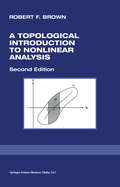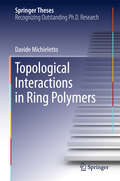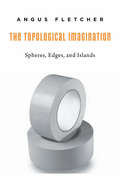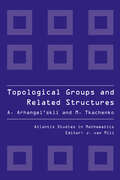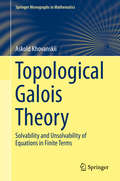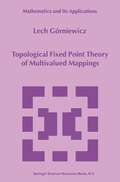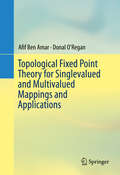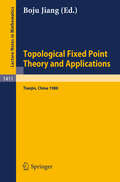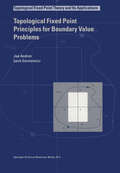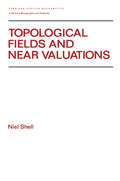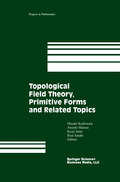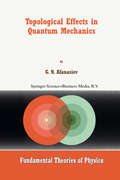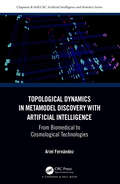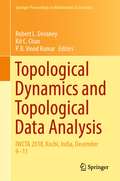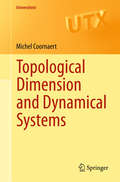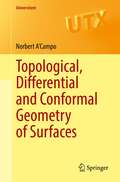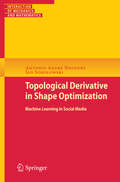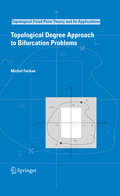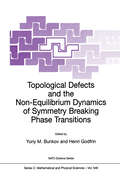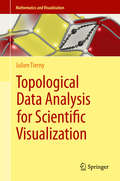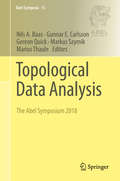- Table View
- List View
A Topological Introduction to Nonlinear Analysis
by Robert F. Brown"The book is highly recommended as a text for an introductory course in nonlinear analysis and bifurcation theory... reading is fluid and very pleasant... style is informal but far from being imprecise." -review of the first edition. New to this edition: additional applications of the theory and techniques, as well as several new proofs. This book is ideal for self-study for mathematicians and students interested in geometric and algebraic topology, functional analysis, differential equations, and applied mathematics.
Topological Interactions in Ring Polymers (Springer Theses)
by Davide MichielettoRing polymers are one of the last big mysteries in polymer physics, and this thesis tackles the problem of describing their behaviour when interacting in dense solutions and with complex environments and reports key findings that help shed light on these complex issues. The systems investigated are not restricted to artificial polymer systems, but also cover biologically inspired ensembles, contributing to the broad applicability and interest of the conclusions reached. One of the most remarkable findings is the unambiguous evidence that rings inter-penetrate when in dense solutions; here this behaviour is shown to lead to the emergence of a glassy state solely driven by the topology of the constituents. This novel glassy state is unconventional in its nature and, thanks to its universal properties inherited from polymer physics, will attract the attention of a wide range of physicists in the years to come.
The Topological Imagination: Spheres, Edges, And Islands
by Angus FletcherIn a bold and boundary defining work, Angus Fletcher clears a space for an intellectual encounter with the shape of human imagining. Joining literature and topology—a branch of mathematics—he maps the ways the imagination’s contours are formed by the spherical earth’s patterns and cycles, and shows how the world we inhabit also inhabits us.
Topological Groups and Related Structures, An Introduction to Topological Algebra. (Atlantis Studies in Mathematics #1)
by Alexander Arhangel’skii Mikhail TkachenkoAlgebraandtopology,thetwofundamentaldomainsofmathematics,playcomplem- tary roles. Topology studies continuity and convergence and provides a general framework to study the concept of a limit. Much of topology is devoted to handling in?nite sets and in?nity itself; the methods developed are qualitative and, in a certain sense, irrational. - gebra studies all kinds of operations and provides a basis for algorithms and calculations. Very often, the methods here are ?nitistic in nature. Because of this difference in nature, algebra and topology have a strong tendency to develop independently, not in direct contact with each other. However, in applications, in higher level domains of mathematics, such as functional analysis, dynamical systems, representation theory, and others, topology and algebra come in contact most naturally. Many of the most important objects of mathematics represent a blend of algebraic and of topologicalstructures. Topologicalfunctionspacesandlineartopologicalspacesingeneral, topological groups and topological ?elds, transformation groups, topological lattices are objects of this kind. Very often an algebraic structure and a topology come naturally together; this is the case when they are both determined by the nature of the elements of the set considered (a group of transformations is a typical example). The rules that describe the relationship between a topology and an algebraic operation are almost always transparentandnatural—theoperationhastobecontinuous,jointlyorseparately.
Topological Galois Theory: Solvability and Unsolvability of Equations in Finite Terms (Springer Monographs in Mathematics)
by Askold KhovanskiiThis book provides a detailed and largely self-contained description of various classical and new results on solvability and unsolvability of equations in explicit form. In particular, it offers a complete exposition of the relatively new area of topological Galois theory, initiated by the author. Applications of Galois theory to solvability of algebraic equations by radicals, basics of Picard–Vessiot theory, and Liouville's results on the class of functions representable by quadratures are also discussed. A unique feature of this book is that recent results are presented in the same elementary manner as classical Galois theory, which will make the book useful and interesting to readers with varied backgrounds in mathematics, from undergraduate students to researchers.In this English-language edition, extra material has been added (Appendices A–D), the last two of which were written jointly with Yura Burda.
Topological Fixed Point Theory of Multivalued Mappings (Topological Fixed Point Theory and Its Applications #4)
by Lech GórniewiczThis book is devoted to the topological fixed point theory of multivalued mappings including applications to differential inclusions and mathematical economy. It is the first monograph dealing with the fixed point theory of multivalued mappings in metric ANR spaces. Although the theoretical material was tendentiously selected with respect to applications, the text is self-contained. Current results are presented.
Topological Fixed Point Theory of Multivalued Mappings (Mathematics and Its Applications #495)
by Lech GórniewiczThis book is an attempt to give a systematic presentation of results and meth ods which concern the fixed point theory of multivalued mappings and some of its applications. In selecting the material we have restricted ourselves to study ing topological methods in the fixed point theory of multivalued mappings and applications, mainly to differential inclusions. Thus in Chapter III the approximation (on the graph) method in fixed point theory of multi valued mappings is presented. Chapter IV is devoted to the homo logical methods and contains more general results, e. g. , the Lefschetz Fixed Point Theorem, the fixed point index and the topological degree theory. In Chapter V applications to some special problems in fixed point theory are formulated. Then in the last chapter a direct application's to differential inclusions are presented. Note that Chapter I and Chapter II have an auxiliary character, and only results con nected with the Banach Contraction Principle (see Chapter II) are strictly related to topological methods in the fixed point theory. In the last section of our book (see Section 75) we give a bibliographical guide and also signal some further results which are not contained in our monograph. The author thanks several colleagues and my wife Maria who read and com mented on the manuscript. These include J. Andres, A. Buraczewski, G. Gabor, A. Gorka, M. Gorniewicz, S. Park and A. Wieczorek. The author wish to express his gratitude to P. Konstanty for preparing the electronic version of this monograph.
Topological Fixed Point Theory for Singlevalued and Multivalued Mappings and Applications
by Afif Ben Amar Donal O'ReganThis is a monograph covering topological fixed point theory for several classes of single and multivalued maps. The authors begin by presenting basic notions in locally convex topological vector spaces. Special attention is then devoted to weak compactness, in particular to the theorems of Eberlein–Šmulian, Grothendick and Dunford–Pettis. Leray–Schauder alternatives and eigenvalue problems for decomposable single-valued nonlinear weakly compact operators in Dunford–Pettis spaces are considered, in addition to some variants of Schauder, Krasnoselskii, Sadovskii, and Leray–Schauder type fixed point theorems for different classes of weakly sequentially continuous operators on general Banach spaces. The authors then proceed with an examination of Sadovskii, Furi–Pera, and Krasnoselskii fixed point theorems and nonlinear Leray–Schauder alternatives in the framework of weak topologies and involving multivalued mappings with weakly sequentially closed graph. These results are formulated in terms of axiomatic measures of weak noncompactness. The authors continue to present some fixed point theorems in a nonempty closed convex of any Banach algebras or Banach algebras satisfying a sequential condition (P) for the sum and the product of nonlinear weakly sequentially continuous operators, and illustrate the theory by considering functional integral and partial differential equations. The existence of fixed points, nonlinear Leray–Schauder alternatives for different classes of nonlinear (ws)-compact operators (weakly condensing, 1-set weakly contractive, strictly quasi-bounded) defined on an unbounded closed convex subset of a Banach space are also discussed. The authors also examine the existence of nonlinear eigenvalues and eigenvectors, as well as the surjectivity of quasibounded operators. Finally, some approximate fixed point theorems for multivalued mappings defined on Banach spaces. Weak and strong topologies play a role here and both bounded and unbounded regions are considered. The authors explicate a method developed to indicate how to use approximate fixed point theorems to prove the existence of approximate Nash equilibria for non-cooperative games.Fixed point theory is a powerful and fruitful tool in modern mathematics and may be considered as a core subject in nonlinear analysis. In the last 50 years, fixed point theory has been a flourishing area of research. As such, the monograph begins with an overview of these developments before gravitating towards topics selected to reflect the particular interests of the authors.
Topological Fixed Point Theory and Applications: Proceedings of a Conference held at the Nankai Institute of Mathematics, Tianjin, PR China, April 5-8, 1988 (Lecture Notes in Mathematics #1411)
by Boju JiangThis selection of papers from the Beijing conference gives a cross-section of the current trends in the field of fixed point theory as seen by topologists and analysts. Apart from one survey article, they are all original research articles, on topics including equivariant theory, extensions of Nielsen theory, periodic orbits of discrete and continuous dynamical systems, and new invariants and techniques in topological approaches to analytic problems.
Topological Fixed Point Principles for Boundary Value Problems (Topological Fixed Point Theory and Its Applications #1)
by J. Andres Lech GórniewiczTopological Fields and Near Valuations
by Niel ShellPart I (eleven chapters) of this text for graduate students provides a Survey of topological fields, while Part II (five chapters) provides a relatively more idiosyncratic account of valuation theory.
Topological Fields and Near Valuations
by Niel ShellPart I (eleven chapters) of this text for graduate students provides a Survey of topological fields, while Part II (five chapters) provides a relatively more idiosyncratic account of valuation theory.
Topological Field Theory, Primitive Forms and Related Topics (Progress in Mathematics #160)
by A. Kashiwara A. Matsuo K. Saito I. SatakeAs the interaction of mathematics and theoretical physics continues to intensify, the theories developed in mathematics are being applied to physics, and conversely. This book centers around the theory of primitive forms which currently plays an active and key role in topological field theory (theoretical physics), but was originally developed as a mathematical notion to define a "good period mapping" for a family of analytic structures. The invited papers in this volume are expository in nature by participants of the Taniguchi Symposium on "Topological Field Theory, Primitive Forms and Related Topics" and the RIMS Symposium bearing the same title, both held in Kyoto. The papers reflect the broad research of some of the world's leading mathematical physicists, and should serve as an excellent resource for researchers as well as graduate students of both disciplines.
Topological Effects in Quantum Mechanics (Fundamental Theories of Physics #107)
by G.N. AfanasievAmong the subjects covered in this volume are the topological effects of quantum mechanics, including Bohm-Aharonov and Aharonov-Casher effects and their generalisations; the toroidal moments, anapoles and their generalisations; the numerical investigation of Tonomura experiments testing the foundations of quantum mechanics; the time-dependent Bohm-Aharonov effect, the thorough study of toroidal solenoids and their use as effective transmitters of electromagnetic waves; and the topical questions of the Vavilov-Cherenkov radiation. Furthermore, concrete advice is given for the construction of magnetic and electric solenoids and the performance of experiments on the Bohm-Aharonov effect. In addition, properties of remarkable charge-current configurations and practical applications are studied. Audience: This volume will be of interest to postgraduate students and researchers dealing with new effective sources of electromagnetic waves.
Topological Dynamics of Enveloping Semigroups (SpringerBriefs in Mathematics)
by Anima Nagar Manpreet SinghThis book introduces the theory of enveloping semigroups—an important tool in the field of topological dynamics—introduced by Robert Ellis. The book deals with the basic theory of topological dynamics and touches on the advanced concepts of the dynamics of induced systems and their enveloping semigroups. All the chapters in the book are well organized and systematically dealing with introductory topics through advanced research topics. The basic concepts give the motivation to begin with, then the theory, and finally the new research-oriented topics. The results are presented with detailed proof, plenty of examples and several open questions are put forward to motivate for future research. Some of the results, related to the enveloping semigroup, are new to the existing literature. The enveloping semigroups of the induced systems is considered for the first time in the literature, and some new results are obtained. The book has a research-oriented flavour in the field of topological dynamics.
Topological Dynamics in Metamodel Discovery with Artificial Intelligence: From Biomedical to Cosmological Technologies (Chapman & Hall/CRC Artificial Intelligence and Robotics Series)
by Ariel FernándezThe leveraging of artificial intelligence (AI) for model discovery in dynamical systems is cross-fertilizing and revolutionizing both disciplines, heralding a new era of data-driven science. This book is placed at the forefront of this endeavor, taking model discovery to the next level. Dealing with artificial intelligence, this book delineates AI’s role in model discovery for dynamical systems. With the implementation of topological methods to construct metamodels, it engages with levels of complexity and multiscale hierarchies hitherto considered off limits for data science. Key Features: Introduces new and advanced methods of model discovery for time series data using artificial intelligence Implements topological approaches to distill "machine-intuitive" models from complex dynamics data Introduces a new paradigm for a parsimonious model of a dynamical system without resorting to differential equations Heralds a new era in data-driven science and engineering based on the operational concept of "computational intuition" Intended for graduate students, researchers, and practitioners interested in dynamical systems empowered by AI or machine learning and in their biological, engineering, and biomedical applications, this book will represent a significant educational resource for people engaged in AI-related cross-disciplinary projects.
Topological Dynamics in Metamodel Discovery with Artificial Intelligence: From Biomedical to Cosmological Technologies (Chapman & Hall/CRC Artificial Intelligence and Robotics Series)
by Ariel FernándezThe leveraging of artificial intelligence (AI) for model discovery in dynamical systems is cross-fertilizing and revolutionizing both disciplines, heralding a new era of data-driven science. This book is placed at the forefront of this endeavor, taking model discovery to the next level. Dealing with artificial intelligence, this book delineates AI’s role in model discovery for dynamical systems. With the implementation of topological methods to construct metamodels, it engages with levels of complexity and multiscale hierarchies hitherto considered off limits for data science. Key Features: Introduces new and advanced methods of model discovery for time series data using artificial intelligence Implements topological approaches to distill "machine-intuitive" models from complex dynamics data Introduces a new paradigm for a parsimonious model of a dynamical system without resorting to differential equations Heralds a new era in data-driven science and engineering based on the operational concept of "computational intuition" Intended for graduate students, researchers, and practitioners interested in dynamical systems empowered by AI or machine learning and in their biological, engineering, and biomedical applications, this book will represent a significant educational resource for people engaged in AI-related cross-disciplinary projects.
Topological Dynamics and Topological Data Analysis: IWCTA 2018, Kochi, India, December 9–11 (Springer Proceedings in Mathematics & Statistics #350)
by Robert L. Devaney Kit C. Chan P. B. Vinod KumarThis book collects select papers presented at the International Workshop and Conference on Topology & Applications, held in Kochi, India, from 9–11 December 2018. The book discusses topics on topological dynamical systems and topological data analysis. Topics are ranging from general topology, algebraic topology, differential topology, fuzzy topology, topological dynamical systems, topological groups, linear dynamics, dynamics of operator network topology, iterated function systems and applications of topology. All contributing authors are eminent academicians, scientists, researchers and scholars in their respective fields, hailing from around the world. The book is a valuable resource for researchers, scientists and engineers from both academia and industry.
Topological Dimension and Dynamical Systems (Universitext)
by Michel CoornaertTranslated from the popular French edition, the goal of the book is to provide a self-contained introduction to mean topological dimension, an invariant of dynamical systems introduced in 1999 by Misha Gromov. The book examines how this invariant was successfully used by Elon Lindenstrauss and Benjamin Weiss to answer a long-standing open question about embeddings of minimal dynamical systems into shifts.A large number of revisions and additions have been made to the original text. Chapter 5 contains an entirely new section devoted to the Sorgenfrey line. Two chapters have also been added: Chapter 9 on amenable groups and Chapter 10 on mean topological dimension for continuous actions of countable amenable groups. These new chapters contain material that have never before appeared in textbook form. The chapter on amenable groups is based on Følner’s characterization of amenability and may be read independently from the rest of the book.Although the contents of this book lead directly to several active areas of current research in mathematics and mathematical physics, the prerequisites needed for reading it remain modest; essentially some familiarities with undergraduate point-set topology and, in order to access the final two chapters, some acquaintance with basic notions in group theory. Topological Dimension and Dynamical Systems is intended for graduate students, as well as researchers interested in topology and dynamical systems. Some of the topics treated in the book directly lead to research areas that remain to be explored.
Topological, Differential and Conformal Geometry of Surfaces (Universitext)
by Norbert A'CampoThis book provides an introduction to the main geometric structures that are carried by compact surfaces, with an emphasis on the classical theory of Riemann surfaces. It first covers the prerequisites, including the basics of differential forms, the Poincaré Lemma, the Morse Lemma, the classification of compact connected oriented surfaces, Stokes’ Theorem, fixed point theorems and rigidity theorems. There is also a novel presentation of planar hyperbolic geometry. Moving on to more advanced concepts, it covers topics such as Riemannian metrics, the isometric torsion-free connection on vector fields, the Ansatz of Koszul, the Gauss–Bonnet Theorem, and integrability. These concepts are then used for the study of Riemann surfaces. One of the focal points is the Uniformization Theorem for compact surfaces, an elementary proof of which is given via a property of the energy functional. Among numerous other results, there is also a proof of Chow’s Theorem on compact holomorphic submanifolds in complex projective spaces. Based on lecture courses given by the author, the book will be accessible to undergraduates and graduates interested in the analytic theory of Riemann surfaces.
Topological Derivatives in Shape Optimization (Interaction of Mechanics and Mathematics)
by Antonio André Novotny Jan SokołowskiThe topological derivative is defined as the first term (correction) of the asymptotic expansion of a given shape functional with respect to a small parameter that measures the size of singular domain perturbations, such as holes, inclusions, defects, source-terms and cracks. Over the last decade, topological asymptotic analysis has become a broad, rich and fascinating research area from both theoretical and numerical standpoints. It has applications in many different fields such as shape and topology optimization, inverse problems, imaging processing and mechanical modeling including synthesis and/or optimal design of microstructures, fracture mechanics sensitivity analysis and damage evolution modeling. Since there is no monograph on the subject at present, the authors provide here the first account of the theory which combines classical sensitivity analysis in shape optimization with asymptotic analysis by means of compound asymptotic expansions for elliptic boundary value problems. This book is intended for researchers and graduate students in applied mathematics and computational mechanics interested in any aspect of topological asymptotic analysis. In particular, it can be adopted as a textbook in advanced courses on the subject and shall be useful for readers interested on the mathematical aspects of topological asymptotic analysis as well as on applications of topological derivatives in computation mechanics.
Topological Degree Approach to Bifurcation Problems (Topological Fixed Point Theory and Its Applications #5)
by Michal Fečkan1. 1 Preface Many phenomena from physics, biology, chemistry and economics are modeled by di?erential equations with parameters. When a nonlinear equation is est- lished, its behavior/dynamics should be understood. In general, it is impossible to ?nd a complete dynamics of a nonlinear di?erential equation. Hence at least, either periodic or irregular/chaotic solutions are tried to be shown. So a pr- erty of a desired solution of a nonlinear equation is given as a parameterized boundary value problem. Consequently, the task is transformed to a solvability of an abstract nonlinear equation with parameters on a certain functional space. When a family of solutions of the abstract equation is known for some para- ters, the persistence or bifurcations of solutions from that family is studied as parameters are changing. There are several approaches to handle such nonl- ear bifurcation problems. One of them is a topological degree method, which is rather powerful in cases when nonlinearities are not enough smooth. The aim of this book is to present several original bifurcation results achieved by the author using the topological degree theory. The scope of the results is rather broad from showing periodic and chaotic behavior of non-smooth mechanical systems through the existence of traveling waves for ordinary di?erential eq- tions on in?nite lattices up to study periodic oscillations of undamped abstract waveequationsonHilbertspaceswithapplicationstononlinearbeamandstring partial di?erential equations. 1.
Topological Defects and the Non-Equilibrium Dynamics of Symmetry Breaking Phase Transitions (Nato Science Series C: #549)
by Yuriy M. Bunkov Henri GodfrinTopological defects formed at symmetry-breaking phase transitions play an important role in many different fields of physics. They appear in many condensed-matter systems at low temperature; examples include vortices in superfluid helium-4, a rich variety of defects in helium-3, quantized mag netic flux tubes in type-II superconductors, and disclination lines and other defects in liquid crystals. In cosmology, unified gauge theories of particle interactions suggest a sequence of phase transitions in the very early uni verse some of which may lead to defect formation. In astrophysics, defects play an important role in the dynamics of neutron stars. In 1997 the European Science Foundation started the scientific network "Topological defects" headed by Tom Kibble. This network has provided us with a unique opportunity of establishing a collaboration between the representatives of these very different branches of modern physics. The NATO-ASI (Advanced Study Institute), held in Les Houches in February 1999 thanks to the support of the Scientific Division of NATO, the European Science Foundation and the CNRS, represents a key event of this ESF network. It brought together participants from widely different fields, with diverse expertise and vocabulary, fostering the exchange of ideas. The lectures given by particle physicists, cosmologists and condensed matter physicists are the result of the fruitful collaborations established since 1997 between groups in several European countries and in the U.S.A.
Topological Data Analysis for Scientific Visualization (Mathematics and Visualization)
by Julien TiernyCombining theoretical and practical aspects of topology, this book provides a comprehensive and self-contained introduction to topological methods for the analysis and visualization of scientific data.Theoretical concepts are presented in a painstaking but intuitive manner, with numerous high-quality color illustrations. Key algorithms for the computation and simplification of topological data representations are described in detail, and their application is carefully demonstrated in a chapter dedicated to concrete use cases.With its fine balance between theory and practice, "Topological Data Analysis for Scientific Visualization" constitutes an appealing introduction to the increasingly important topic of topological data analysis for lecturers, students and researchers.
Topological Data Analysis: The Abel Symposium 2018 (Abel Symposia #15)
by Nils A. Baas Gunnar E. Carlsson Gereon Quick Markus Szymik Marius ThauleThis book gathers the proceedings of the 2018 Abel Symposium, which was held in Geiranger, Norway, on June 4-8, 2018. The symposium offered an overview of the emerging field of "Topological Data Analysis". This volume presents papers on various research directions, notably including applications in neuroscience, materials science, cancer biology, and immune response. Providing an essential snapshot of the status quo, it represents a valuable asset for practitioners and those considering entering the field.
